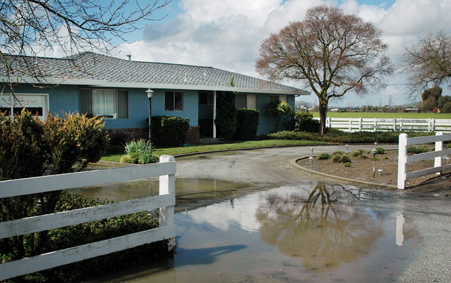
New report sheds light on the number of homeowners who don’t
think it will happen to them
By LARA JAKES JORDAN
Associated Press Writer
The Pacific storms that have dumped buckets of rain across
southern Santa Clara and San Benito counties this past week are
reminders that you don’t always have to live in a flood plain to be
affected by nature’s whims.
New report sheds light on the number of homeowners who don’t think it will happen to them
By LARA JAKES JORDAN
Associated Press Writer
The Pacific storms that have dumped buckets of rain across southern Santa Clara and San Benito counties this past week are reminders that you don’t always have to live in a flood plain to be affected by nature’s whims.
About half of the homeowners who live in federally designated flood plains do not have flood insurance, a nationwide study indicates.
Maria Mendoza of the Farmers Insurance Group in Hollister notes that in California, most lenders won’t close mortgage loans for homes in flood plains unless they have flood insurance.
Consequently most homeowners buying flood insurance do so only because it is required in areas considered most vulnerable to flooding, the study found. When they don’t have to, many homeowners skip the cost of insurance and risk sometimes catastrophic destruction. Just 20 percent of homeowners living in the most flood-prone areas buy federal flood insurance when they are not required to do so, the study says.
“Substantial flood damage from Hurricane Katrina was suffered by homes located in flood zones whose owners were not required to purchase flood insurance,” said Lloyd Dixon, lead author of the report.
Only about 1 percent of Americans living outside flood zones buy federal flood insurance, according to the study, even though they sometimes become flood victims as well.
But more single-family homeowners in the South – including those in the hurricane-ravaged Gulf Coast – are insured than elsewhere across the country, according to the RAND Corp. study released Monday.
The new data come as the Federal Emergency Management Agency prepares to issue flood elevation maps that will likely require more homeowners to carry insurance – and, ultimately, dictate how hurricane victims are allowed to rebuild. The maps are expected in the next several weeks, FEMA spokeswoman Nicol Andrews said.
West Virginia officials proposed a five-year plan to map the state’s flood-prone areas following a series of floods across the state in recent years. Last year, officials said many areas have either not been mapped, or the maps on file had not been updated in 30 years.
Federal officials have declared 16 flood-related disasters in West Virginia since 1996.
“There hasn’t been very reliable information about the percentage of homeowners who have flood insurance, and that has big implications for what uninsured losses are like during an event,” said RAND researcher Lloyd Dixon, who wrote the highly technical report on flood insurance rates in 100 communities nationwide. It surveyed 750 properties in each community.
Overall, between 50 percent and 52 percent of people who own single-family homes in flood plains carry such insurance, the study concluded. But it found that a quarter of homeowners whose federally backed mortgages require them to be insured against floods actually are not, and Dixon noted that compliance “is not perfectly enforced.”
About 60 percent of homeowners in the South and West have flood insurance, compared with 20 percent to 30 percent in the Midwest and Northeast. Dixon said that gap likely reflects the few massive floods in those regions despite the widespread damage caused by the 1993 Midwest floods and a 1938 hurricane that killed 700 New Yorkers and New Englanders and left 63,000 homeless.
According to FEMA, 270 West Virginia communities participate in National Flood Insurance Program. The program requires local officials to adopt and enforce flood plain management ordinances to reduce future flood damage.
During the recent 60-day legislative session, West Virginia lawmakers passed a bill requiring county school districts to maintain flood insurance on buildings in a 100-year flood plain that have replacement values exceeding $300,000 and on buildings that have been damaged in a previous flood. The insurance must fully cover contents.
Unsurprisingly, the report found that homeowners in coastal areas are more likely to have flood insurance than those in landlocked regions. It also found that people in smaller communities are less likely to be insured – possibly in part because “there may be less appreciation of risk when there’s just a small number of homes affected,” Dixon said.
Additionally, while 62 percent of homeowners who have suffered flooding within a five-year period are insured, the rate dropped by half – to 31 percent – in communities that are only flooded once in a decade.
The RAND report did not examine insurance rates specifically in Louisiana or Mississippi, which suffered the most flood damage when Hurricane Katrina hit last Aug. 29.
Pinnacle City Editor Dennis Taylor contributed to this report.









